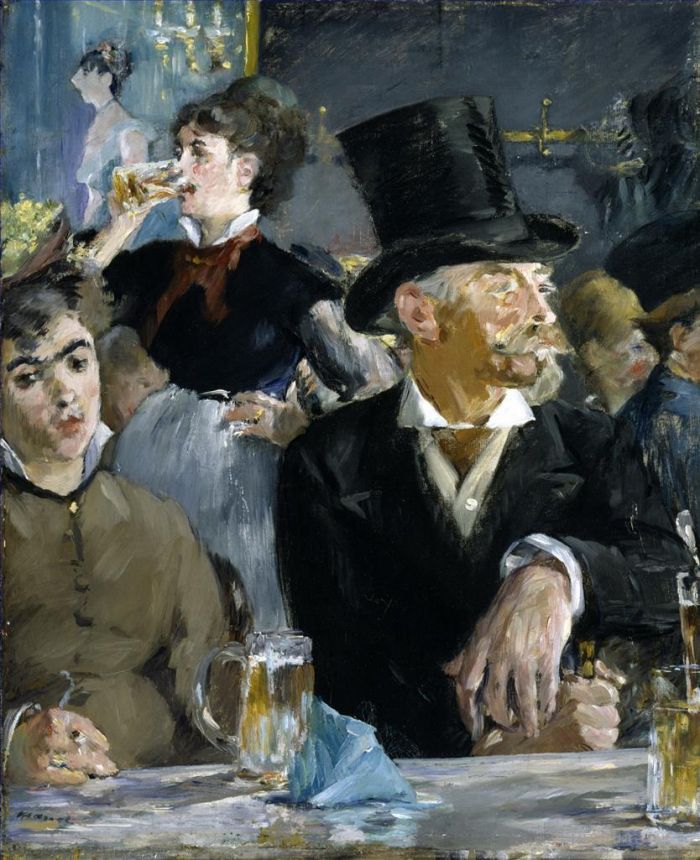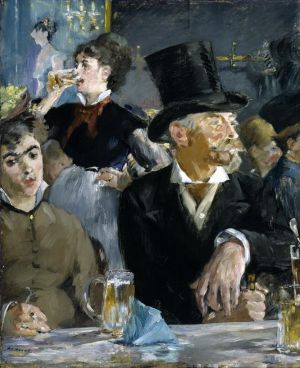The Café-Concert (At the Café or The Bock Drinkers)
Edouard Manet
- Price: Price on Request
- Art Type: Oil Painting
- Size:
- English Comments: 0
- International Comments: 0
- Creating Date:
- Introduction and Works of Edouard Manet >>
Work Overview
- The Café-Concert (At the Café; The Bock Drinkers)
Artist Édouard Manet
Year circa 1879
Medium Oil on canvas
Dimensions 47.3 cm × 39.1 cm (18.6 in × 15.4 in)
Location The Walters Art Museum, Baltimore
The Café-Concert is a 1879 painting by the French painter Édouard Manet, who often captured café scenes depicting social life at the end of the nineteenth century similar to those depicted in this painting.
The setting has been identified as the Brasserie Reichshoffen on the Boulevard Rochechouart.[2] Manet shows us men and women in the new brasseries and cafes of Paris, which presents the viewer with an alternate view of new Parisian life.[3] Manet claimed he was painting “des oeuvres sinceres” or “sincere works”. The women depicted in these scenes were courting certain risks with regards to perception and morality.
n The Café-Concert, Manet presents a café-concert in which three central figures form a triangle but are all engaged in opposite directions. The scene of a café-concert, supposedly casual, is hinted by Manet to be one of separation. The waitress enjoys a beer, while the woman at the bar smokes a cigarette and appears subdued and the man appears to be at ease as he watches the performance (the singer known as “La Belle Polonaise” is reflected in the mirror in the background of the painting). It is noted that the man evokes confidence, because men unlike women could frequent café’s without insecurity.[3] The painting was posed and completed in a studio but gives the appearance of being freshly observed.
In this painting, concepts of conventional composition are rejected. The figures of the individuals represented are not clearly defined but modeled with brushstrokes. The colors are placed directly on the canvas with loose, repetitive strokes instead of applying layers of pigments and glazes over a dark background.
Currently, The Café-Concert is being featured in Off the Wall, an open-air exhibition on the streets of Baltimore, Maryland. A reproduction of the painting, the original is part of The Walters Art Museum collection, will be on display at the CFG Community Bank (Fell's Point).[5] The National Gallery in London began the concept of bringing art out of doors in 2007 and the Detroit Institute of Art introduced the concept in the U.S.. The Off the Wall reproductions of the Walters' paintings are done on weather-resistant vinyl and include a description of the painting and a QR code for smart phones.
The style known now as bock was a dark, malty, lightly hopped ale first brewed in the 14th century by German brewers in the Hanseatic town of Einbeck. The style from Einbeck was later adopted by Munich brewers in the 17th century and adapted to the new lager style of brewing. Due to their Bavarian accent, citizens of Munich pronounced "Einbeck" as "ein Bock" ("a billy goat"), and thus the beer became known as "bock".
Bock is historically associated with special occasions, often religious festivals such as Christmas, Easter or Lent. Bocks have a long history of being brewed and consumed by Bavarian monks as a source of nutrition during times of fasting.
This painting belongs to Manet's many café scenes such as The Plum Brandy, the Corner of a Café-Concert, and the Bar in the Folies-Bergère.
Among the numerous cafe scenes painted by Manet, this cafe-concert is among the most suggestive. With bold, golden strokes that seem to take their color from the beer in the mugs, Manet shows us people looking on while the singer reflected in the mirror sings herself hoarse. Above and beyond the picture of boulevard life it presents, this painting is remarkable for its brilliance and vigor. Manet has painted the hands with great skill and elegance. (It is interesting to note that his treatment of hands is never so fine as when he has not labored over them too much.) The composition itself is a symphony of blues and golds that illuminate the blacks and impart a lively rhythm to the whole picture.
The setting is the Reichshoffen cabaret on the boulevard Rochechouart. The picture is one of a series of similar scenes painted either here or at the Nouvelle-Athenes. The man in the top hat is one of Manet's regular models; he also posed for the watercolor entitled Punchinello.
Manet liked the atmosphere of cafes and brasseries and often sat in them for relaxation after working. He met his friends there, and most of the knowledge we have of his life and habits comes from the people who used to talk with him or sit near him at the Cafe Guerbois, Tortoni's, or the Nouvelle-Athenes.
- Copyright Statement:
All the reproduction of any forms about this work unauthorized by Singing Palette including images, texts and so on will be deemed to be violating the Copyright Laws.
To cite this webpage, please link back here.
- >> English Comments
- >> Chinese Comments
- >> French Comments
- >> German Comments
- >>Report
- Basket of Fruits
- The monk at prayer
- At Father Lathuille
- The Luncheon on the Grass (The Bath)
- The Grand Canal Venice
- Portrait of Emile Zola
- Portrait of Lina Campineanu
- Young Man in the Costume of a Majo
- The Bullfight
- Bench in autumn
- Victorine Meurent in the costume of an Espada
- Portrait of Zacharie Astruc
- Carnations and clematis in a crystal vase
- A boy with a pitcher
- Madame Brunet
- A matador
- On the Beach at Boulogne
- Reading Mme Manet and Leon
- Peaches
- The Kearsarge at Boulogne (Fishing boat coming in before the wind)
- Interior at Arcachon
- The ragpicker
- Woman in furs
- The model
- Madame Manet on a Blue Sofa
- Monet in his Studio Boat (Claude Monet Painting on His Boat-Studio in Argenteuil)
- Guitar and Hat
- The House at Rueil
- The Suicide
- Branch of White Peonies and Pruning Shears
- Jetty at Boulogne
- Portrait of Faure as Hamlet
- The Railway (Gare Saint-Lazare)
- Marguerite de Conflans Wearing Hood
- Theodore Duret
- Steamboat Leaving Boulogne
- Portrait of Gilbert Marcellin Desboutin
- Still Life Fruits on a Table
- The garden around Manet house
- Corner of a Café-Concert
- Boy with Dog
- Portrait of Mademoiselle Claus
- Young woman with a pink shoe
- Le Bon Bock A Good Glass of Beer
- Boy Blowing Bubbles
- Berthe Morisot with a Bouquet of Violets
- Portrait of Monsieur Brun
- Portrait of Emilie Ambre in the role of Carmen
- Effect of Snow at Petit Montrouge
- Vase of White Lilacs and Roses
- View of the 1867 Exposition Universelle
- Study of trees
- Moss Roses in a Vase
- Angelina
- Roses in a Champagne Glass
- Spring Study of Jeanne Demarsy
- The barque of Dante Copy after Delacroix
- The Street Singer
- Singer at a Cafe Concert
- Baudelaires Mistress Reclining Study of Jeanne Duval
- The Lemon
- Repose Study of
- A Game of Croquet
- Polichinelle
- Masked Ball at the Opera
- Bundle of Asparagus
- The Departure Of The Folkestone Boat
- The spanish ballet
- Argenteuil
- Plum
- At the Cafe
- Bench
- Gypsy with a Cigarette
- Rose and tulip
- Vase of Peonies on a Small Pedestal
- The Dead Christ with Angels
- Stephane Mallarme
- Nana
- Music in the Tuileries
- Christ with Angels
- Madame Manet in conservatory
- Swallows
- The Luncheon in the Studio
- Flowers in a Crystal Vase
- Madame Manet at the Piano
- Rochefort Escape
- The philosopher
- Still Life with Brioche
- Lola de Valence
- Bull fighting scene
- Portrait of Eva Gonzales
- Bouquet of flowers
- Eva Gonzales
- The Spanish Singer The Guitar Player
- Portrait of Mademoiselle Isabelle Lemonnier
- The Blonde with Bare Breasts
- The Waitress
- Woman with umbrella
- Young woman in the garden
- A Corner of the Garden in Rueil
- Madame Manet at Bellevue
- The Rest portrait of
- Woman Reading
- Bathers on the Seine
- Two Roses on a Tablecloth
- Le Chemin De Fer The Railroad
- The burial
- Execution of the Emperor Maximilian
- Embarkation after Folkestone
- Portrait of Henry Bernstein as a Child
- Head of a Dog
- The head of Christ
- Mother in the Garden at Bellevue
- Autumn Study of Mery Laurent
- The Races in the Bois de Boulogne
- Still life with melon and peaches
- Woman Before a Mirror
- Jesus Mocked by the Soldiers
- Flowers In A Crystal Vase flower Impressionism Edouard Manet
- The Port of Bordeaux
- A brioche
- Rue Mosnier decorated with Flags
- The Banks of the Seine at Argenteuil
- Lilac in a glass
- Woman Pouring Water Study of Suzanne Leenhoff
- The Monet family in their garden at Argenteuil
- View of Holland
- Portrait of Antonin Proust Realism Impressionism Edouard Manet
- Boating
- A King Charles Spanie
- Peonies in a vase
- The Horsewoman
- M and Mme Auguste Manet
- The conservatory
- Woman in a Tub
- A young man peeling a pear
- The Jetty at Boulogne
- Interior of a Cafe
- The ham
- On The Beach
- Pertuiset Lion Hunter
- The grand canal of Venice
- Oysters
- The Execution of the Emperor Maximilian of Mexico
- In the garden
- Portrait of Antonin Proust
- Victorine Meurent
- Young woman with a book
- Tarring the Boat
- Young woman in a round hat
- The Races at Longchamp
- The Milliner
- At the races
- The absinthe drinker
- Olympia
- Seascape at Berck Fishing Boats and Fishermen
- The old musician
- The Balcony
- Fishing
- Madame Auguste Manet
- The Boy with Cherries
- The Fifer
- Women at the Races
- Portrait of Suzanne Manet
- Surprised Nymph
- Portrait of Monsieur Tillet
- Almonds currants and peaches
- The stroll
- Young Woman in Oriental Garb
- Battle of Kearsage and Alabama
- The road menders Rue de Berne
- Woman with a Parrot
- Boy with a sword
- Eel and Red Mullet
- Woman with Fans (The Lady with Fans or Portrait of Nina de Callias)
- The Café-Concert (At the Café or The Bock Drinkers)
- The salmon
- Seascape at Arcachon
- The Garden at Bellevue
- The dead toreador
- Young Woman Reclining in Spanish Costume
- Young woman among the flowers
- Woman fastening her garter
- A Bar at the Folies-Bergère
- Bouquet Of Violets still life Impressionism Edouard Manet
- The Port of Bordeaux 2
- Head Of A Man
- Young woman in a negligee
- Portrait Of Mme Jules Guillemet
- On the Bench
- The Barricade Civil War









 Singing Palette
Singing Palette